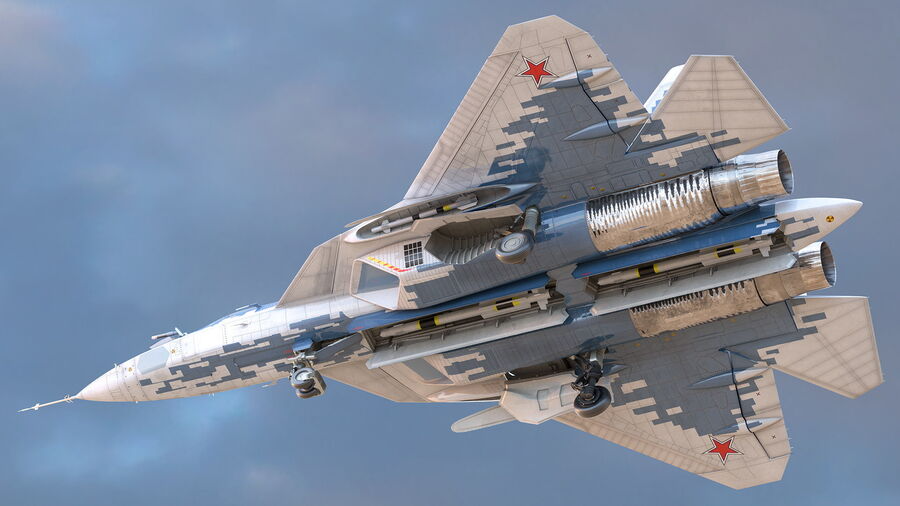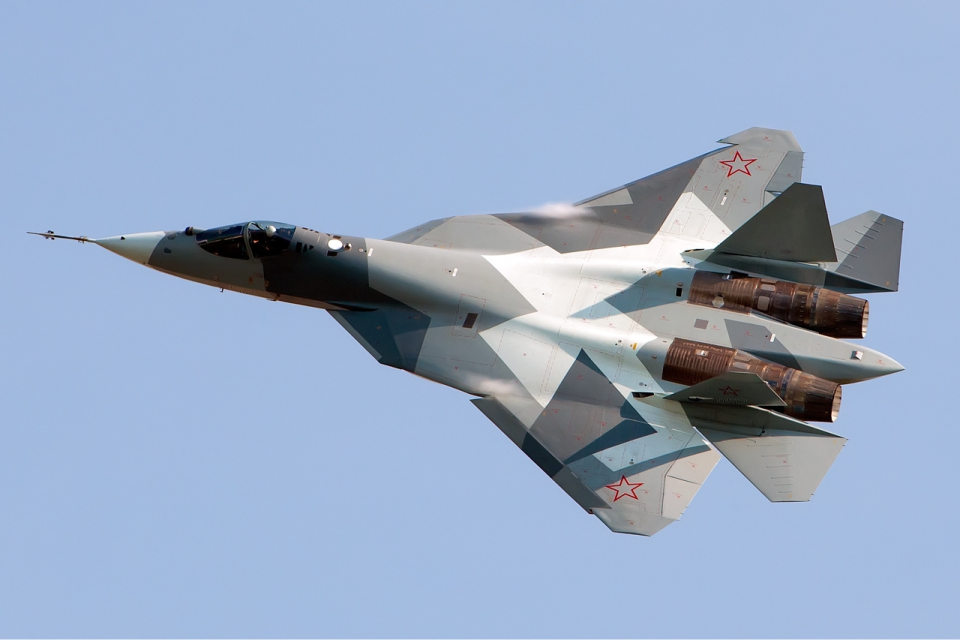Unveiling the Su-57: Russia’s ‘not-quite-fifth’ generation fighter and its performance shortcomings

A Su-57 multi-role fighter jet was struck at the Akhtubinsk airfield in Russia’s Astrakhan Oblast on June 8, 589 kilometers from the front line, Ukraine’s Main Intelligence Directorate (HUR) reported. This is the first such case in history.

Here is what is known about Russian Su-57 aircraft, which Russia has rarely used in the war against Ukraine because of their value and small numbers.
Su-57: the “not-quite-fifth” generation aircraft
The Su-57 (NATO codified Felon) is a Russian multi-role fighter aircraft that Russia classifies as a fifth-generation aircraft, i.e. the most modern type of jet fighter.
The aircraft was developed by the Russian Sukhoi Research and Development Bureau. Initially, India was also involved in the development, but later withdrew from the program.
The Su-57 made its first flight in January 2010. In 2019, Russia announced the start of serial production of such aircraft, and in 2020 the production of the first production Su-57.

Aircraft specifications:
Crew: 1 person
Length: 19.7 m
Wingspan: 14 m
Height: 4,8 m
Weight: empty - 18.5 tons; normal takeoff weight: with 63% fuel - 26 tons; with 100% fuel - 30 tons
Maximum speed at altitude: Mach 2.45 (about 2,600 km/h), maximum afterburner speed 2 Mach (about 2,100 km/h)
Flight duration: up to 5.8 hours
Operational ceiling: 20,000 m.
At the same time, fifth-generation aircraft, to which Russia attributes the Su-57, should have several exceptional characteristics, including:
highly efficient engines
the ability to cruise at supersonic speeds without the use of afterburner
high speed performance (maximum afterburner-free speed – not less than Mach 2)
ultra-maneuverability
radical reduction of the aircraft's visibility, in particular radar and infrared, due to stealth technologies (changes in the geometry of the aircraft and engine nozzles
use of radio-transparent composite materials and radio-absorbing coatings, as well as the transition of onboard sensors to passive methods of obtaining information and modes of increased stealth).
However, in practice, the Russian Su-57 does not meet several of these characteristics, as Ukrainian experts have repeatedly stressed.
"The current Su-57, which Russia initially claimed would have new equipment, a flat nozzle, but failed to implement, is powered by modernized engines from the Su-27," Oleh Katkov, editor-in-chief of the Defence Express military portal, told NV in an interview in the fall of 2023.
“In fact, it is a globe-trotting 4th+ generation aircraft.”
His opinion was seconded by a well-known aviation expert Valeriy Romanenko, a leading researcher at the National Academy of Sciences in April 2024.
"In general, why is it [the Su-57] the ‘not-quite-fifth’ generation?" Romanenko said.
Read also: Ukraine's SBU damages Russian Su-27 fighter jet sitting on tarmac at Russian airfield
“Because it was developed together with Indian specialists, but back in 2018-2019, the Indians withdrew from this project because they were convinced that the Russians did not have the appropriate technologies. First, there is no newly developed engine. The Su-57 still has the same engines as the Su-34 and Su-35. And there should be an engine with a nozzle that reduces thermal radiation. This is precisely to implement the stealth technology in the thermal spectrum as well.”
Secondly, he explained, the fifth-generation aircraft must be very deeply integrated into all command and control systems, including those of air defense, space and even ground forces. For example, the American JSF (Joint Strike Fighter) F-35 Lightning II, which is being adopted by NATO countries, can "be linked to any missile or artillery unit without additional headquarters and adjust artillery fire," explained Romanenko.
"If it sees an anti-aircraft system near the front in the place where it is flying, the integration is so high that it can transmit information to the command post on its own," the expert stated.
“He selects a unit on his tactical information display, instantly contacts it and engages the threat to itself. The Russians have no such integration of combat control systems [in the Su-57]. They are simply not capable. They need a very high-level information exchange system with a very high capacity to transmit large amounts of information.”
How many Su-57s does Russia have?

Aviation experts state that Russia has not yet managed to establish mass production of Su-57s, so there are few of them in service.
"We're talking about a squadron of planes [12 units], half of which are prototypes and it's not a given that they are fully equipped," Oleh Katkov, editor-in-chief of Defence Express, told NV in the fall of 2023.
“The Russians are ‘fiddling’ a lot and, as I understood it, took prototypes for trial operation and thus blurred the real number of aircraft.”
Currently, the Russian military-industrial complex cannot produce these aircraft normally, in part because of the impact of sanctions, he added.
"Therefore, the production rate may be low or nonexistent," Katkov recalled.
Read also: Russia's advanced Su-57 fighter jet hit in Astrakhan Oblast — HUR
“And this is a reality, because the Russian army planned to adopt Su-57s in large numbers. They were shouting about hundreds of units with the start of deliveries in 2014, and later the [planned] number was reduced to 76 units by 2028.”
Romanenko voiced similar estimates. He explained that the Su-57 aircraft were supposed to "gradually replace the entire Su-272 line," i.e., become a replacement for the Russian Su-27, Su-30, and Su-35. "But the Russians cannot realize this," Romanenko stated.
According to his estimates, the Russians have produced about 10 Su-57s so far.
"One (the very first) was crashed right during testing at the factory," the aviation expert said.
“And most of them were produced in 2022 – six aircraft. In 2023, the pace dropped sharply, with only two aircraft produced. In total, the Russians plan to have 70 such fighters by 2027. By that time, Europe will have more than 700 Joint Strike Fighter aircraft. That is, Russia will not have parity here.”
What are the Su-57s armed with and what missiles do they carry?
The aircraft is armed with a 30-mm built-in cannon and can carry up to 10 tons of ammunition. Some of the weapons can be placed in the internal compartments of the fuselage to reduce radar visibility, which is one of the main requirements for stealth technology of this class of aircraft.
In particular, for air combat, it is equipped with RVV-MD2 and RVV-SD R-77M missiles, while the Su-57 can strike ground targets with missiles (Kh-35, Kh-38, Kh-58UShK, Kh-59, Kh-69) or guided bombs (KAB-1500 - only on the external suspension, as well as KAB-500 and KAB-250).
One of the most dangerous types of missiles in service with the Su-57 is the Kh-69 cruise missile, a very conventional Russian analog of the Storm Shadow and Taurus.
"This precision-guided weapon, originally developed for the Su-57 [aircraft], is far more advanced than most Russian air-launched tactical munitions," The War Zone warned in February 2024.
It was with these missiles that Russia destroyed the Trypillia Thermal Power Plant on April 11, 2024. However, the Air Force did not report which aircraft was used in the attack or whether it was a Su-57.
The Kh-69 missile was designed specifically for the internal compartments of the Su-57, so it has a specific body shape – in particular, a square cross-section (similar to the German Taurus missiles), rather than the more traditional round one, as was the previous version of this munition, the Kh-59MK2.
These missiles have a range of up to 290 kilometers, although after the attack on the Trypillia TPP, experts speculated that the range could be increased to 400 kilometers. In addition to the Su-57, the Kh-69 missiles are also capable of launching fourth-generation aircraft, including the Su-35, Su-30MK, and Su-34, which Russia often uses at the front.
Cases of Su-57 use in Ukraine
Russia has been claiming to use Su-57s in the war against Ukraine since the spring of 2022. At the time, TASS news agency reported the first case of the use of such aircraft. However, propagandists admitted that due to the danger of being hit by Ukrainian air defense, the Russians have to use Su-57s very far away, outside the area of active operation of Ukrainian air defense systems.
Defence Express then called this "the tactics of air cowards" and stated that the "stealth fighter" was actually used as a conventional air platform to launch Soviet-era guided missiles from external suspension points instead of precision weapons. According to the portal, on April 8, 2022, the Su-57 could have struck from Russian airspace with Kh-59 missiles at targets in Kirovohrad Oblast and the port of Odesa.
However, as of May 2023, the then Air Force spokesman Yuriy Ihnat stated that the Ukrainian military "did not record the use of these aircraft in air aggression against Ukraine." At the same time, Ihnat suggested that the Russians could have launched Su-57s from a very long way away, but he did not confirm the facts of combat launches at that time.
"The Russian Defense Ministry declares that they were used," Oleh Katkov said in an interview with NV in November 2023.
“But we don't know if it actually happened, because there is no evidence of it. The Russians said the same thing about their [modern] Armata tank.”
Monitoring channels reported on April 13, 2024 that one of the Su-57 fighter jets was spotted over the Black Sea. However, despite the declared "invisibility" of this aircraft, it was "seen" by Ukrainian air defense forces.
The Russians launched a missile attack on Kryvyi Rih from their newest Su-57 fighter jet, which was in the Black Sea on April 25. This is a rare case of confirmed combat use by the Russians of such an aircraft, which can be a carrier of dangerous Kh-69 missiles.
We’re bringing the voice of Ukraine to the world. Support us with a one-time donation, or become a Patron!
Read the original article on The New Voice of Ukraine


